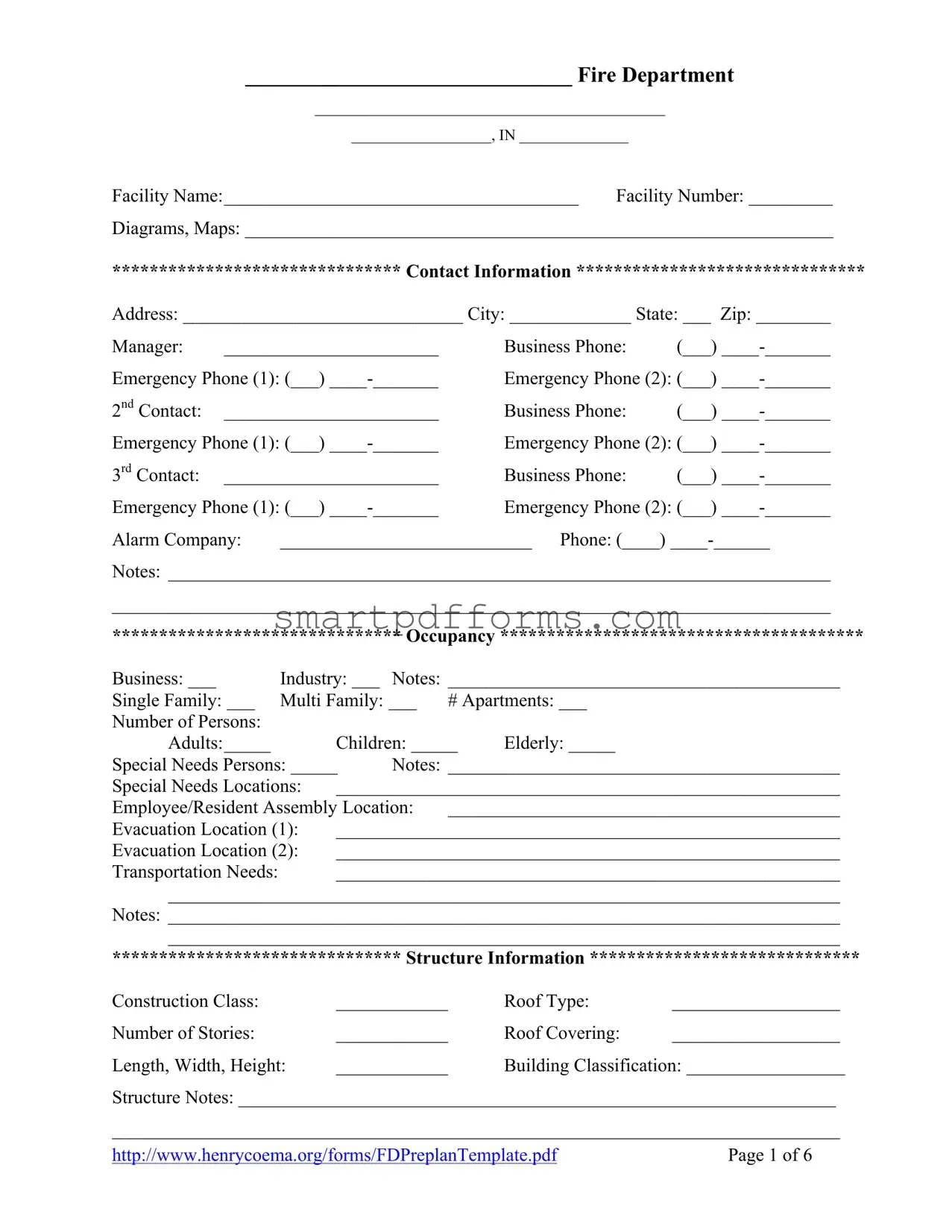______________________________ Fire Department
_____________________________________________
__________________, IN ______________
Facility Name:______________________________________ Facility Number: _________
Diagrams, Maps: _______________________________________________________________
******************************* Contact Information *******************************
Address: ______________________________ City: _____________ State: ___ Zip: ________
Manager: |
_______________________ |
Business Phone: |
(___) ____-_______ |
Emergency Phone (1): (___) ____-_______ |
Emergency Phone (2): (___) ____-_______ |
2nd Contact: |
_______________________ |
Business Phone: |
(___) ____-_______ |
Emergency Phone (1): (___) ____-_______ |
Emergency Phone (2): (___) ____-_______ |
3rd Contact: |
_______________________ |
Business Phone: |
(___) ____-_______ |
Emergency Phone (1): (___) ____-_______ |
Emergency Phone (2): (___) ____-_______ |
Alarm Company: ___________________________ Phone: (____) ____-______
Notes: _______________________________________________________________________
_____________________________________________________________________________
******************************* Occupancy ***************************************
Business: ___ |
Industry: ___ |
Notes: __________________________________________ |
Single Family: ___ |
Multi Family: ___ |
# Apartments: ___ |
Number of Persons: |
|
|
|
|
|
Adults:_____ |
|
Children: _____ |
Elderly: _____ |
Special Needs Persons: _____ |
Notes: __________________________________________ |
Special Needs Locations: |
______________________________________________________ |
Employee/Resident Assembly Location: |
__________________________________________ |
Evacuation Location (1): |
______________________________________________________ |
Evacuation Location (2): |
______________________________________________________ |
Transportation Needs: |
|
______________________________________________________ |
________________________________________________________________________
Notes: ________________________________________________________________________
________________________________________________________________________
******************************* Structure Information *****************************
Construction Class: |
____________ |
Roof Type: |
__________________ |
Number of Stories: |
____________ |
Roof Covering: |
__________________ |
Length, Width, Height: |
____________ |
Building Classification: _________________ |
Structure Notes: ________________________________________________________________
______________________________________________________________________________
http://www.henrycoema.org/forms/FDPreplanTemplate.pdf |
Page 1 of 6 |
******************************* Fire Access Information ***************************
Main Access: |
____________________________________________________________ |
Secondary Access: |
____________________________________________________________ |
Roof Access: |
____________________________________________________________ |
Attic Access: |
____________________________________________________________ |
Basement: |
____________________________________________________________ |
Lowest Access: |
____________________________________________________________ |
Lock Box: |
____________________________________________________________ |
Alarm Panel: |
____________________________________________________________ |
Annunciator Panel: |
____________________________________________________________ |
Notes: _______________________________________________________________________
_____________________________________________________________________________
******************************* Response Information ******************************
Primary Staging: |
____________________________________________________________ |
Secondary Staging: |
____________________________________________________________ |
******************************* Water Supply Information**************************
Hydrant-1 ______________________________________________________________
Volume (GPM) |
________ |
Main Size: |
_____ |
Status: ______________ |
Notes: _______________________________________________________________________
_____________________________________________________________________________
Hydrant-2 ______________________________________________________________
Volume (GPM) |
________ |
Main Size: |
_____ |
Status: ______________ |
Notes: _______________________________________________________________________
_____________________________________________________________________________
Hydrant-3 ______________________________________________________________
Volume (GPM) ________ Main Size: _____ Status: ______________
Notes: _______________________________________________________________________
_____________________________________________________________________________
http://www.henrycoema.org/forms/FDPreplanTemplate.pdf |
Page 2 of 6 |
Alt Supply-1: ______________________________________________________________
Volume (GPM) ________ Main Size: _____ Status: ______________
Notes: _______________________________________________________________________
_____________________________________________________________________________
Alt Supply-2 ______________________________________________________________
Volume (GPM) ________ Main Size: _____ Status: ______________
Notes: _______________________________________________________________________
_____________________________________________________________________________
******************************* Protection Information *****************************
|
Yes/No |
Special Notes |
Sprinklers: |
_____ |
_______________________________________________ |
Spare Heads: |
_____ |
_______________________________________________ |
FD Connection: |
_____ |
_______________________________________________ |
Stand Pipe: |
_____ |
_______________________________________________ |
Gas Shutoff: |
_____ |
_______________________________________________ |
Electrical Shutoff: |
_____ |
_______________________________________________ |
Water Shutoff: |
_____ |
_______________________________________________ |
Notes: _______________________________________________________________________
_____________________________________________________________________________
_____________________________________________________________________________
_____________________________________________________________________________
_____________________________________________________________________________
_____________________________________________________________________________
_____________________________________________________________________________
_____________________________________________________________________________
_____________________________________________________________________________
_____________________________________________________________________________
_____________________________________________________________________________
http://www.henrycoema.org/forms/FDPreplanTemplate.pdf |
Page 3 of 6 |
******************************* HAZMAT ****************************************
Chemical Name: |
___________________________________________________________ |
Location: |
|
___________________________________________________________ |
Quantity: |
_____________ Gallons/Pounds |
|
Flammable: |
____ |
Toxic: ____ |
Corrosive: ____ |
Oxidizer: ____ |
UN #: _____ |
Guide # _____ |
|
|
NFPA 704: |
Fire __ Health __ Reactivity __ Special _________ |
Chemical Name: |
___________________________________________________________ |
Location: |
|
___________________________________________________________ |
Quantity: |
_____________ Gallons/Pounds |
|
Flammable: |
____ |
Toxic: ____ |
Corrosive: ____ |
Oxidizer: ____ |
UN #: _____ |
Guide # _____ |
|
|
NFPA 704: |
Fire __ Health __ Reactivity __ Special _________ |
Chemical Name: |
___________________________________________________________ |
Location: |
|
___________________________________________________________ |
Quantity: |
_____________ Gallons/Pounds |
|
Flammable: |
____ |
Toxic: ____ |
Corrosive: ____ |
Oxidizer: ____ |
UN #: _____ |
Guide # _____ |
|
|
NFPA 704: |
Fire __ Health __ Reactivity __ Special _________ |
Chemical Name: |
___________________________________________________________ |
Location: |
|
___________________________________________________________ |
Quantity: |
_____________ Gallons/Pounds |
|
Flammable: |
____ |
Toxic: ____ |
Corrosive: ____ |
Oxidizer: ____ |
UN #: _____ |
Guide # _____ |
|
|
NFPA 704: |
Fire __ Health __ Reactivity __ Special _________ |
Copy this sheet and attach as many as necessary
http://www.henrycoema.org/forms/FDPreplanTemplate.pdf |
Page 4 of 6 |
Basic Site Plan
http://www.henrycoema.org/forms/FDPreplanTemplate.pdf |
Page 5 of 6 |
Basic Floor Plan, |
____ Floor |
|
|
|
|
Make as many copies as necessary
http://www.henrycoema.org/forms/FDPreplanTemplate.pdf |
Page 6 of 6 |

